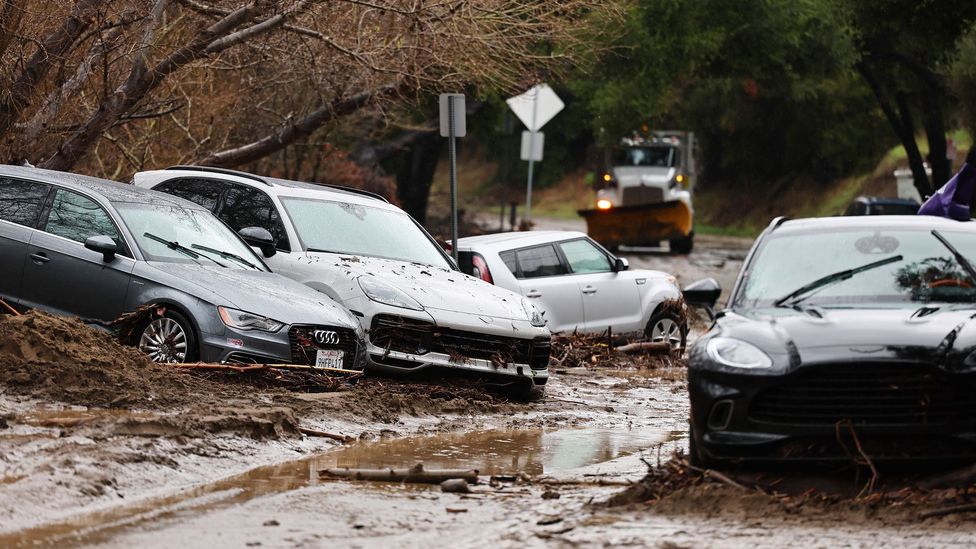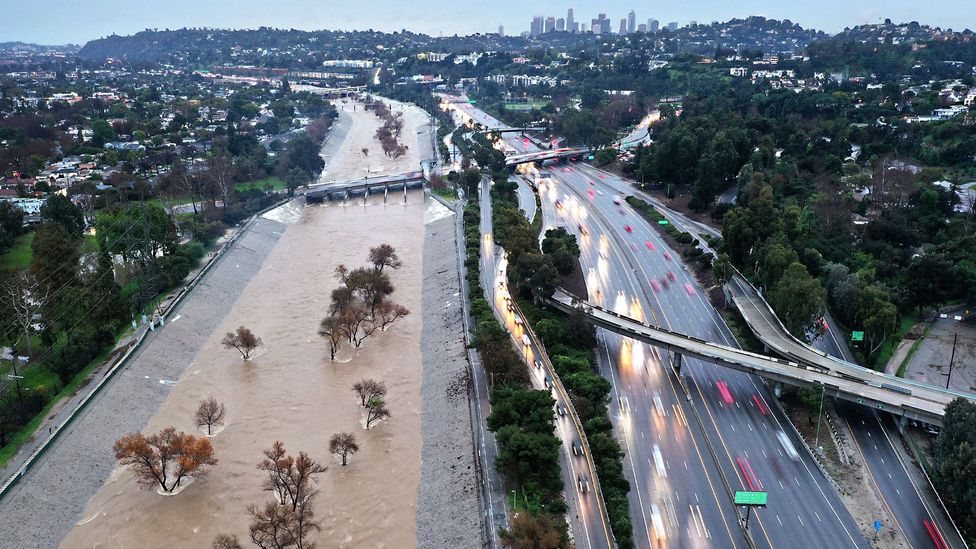The Santa Barbara police car blocked access to the bridge, lights flashing as the thundering, swollen brown river rampaged below. The water was running so high in this Southern California county that it gushed through the railings of the bridge, and poured out onto the road.
This region is familiar with water scarcity – usually battling extreme heatwaves, wildfires, and drought. Now, Southern California is confronting an overabundance of water, in the form of torrential rain and life-threatening floods.
Earlier this week, around half a year's worth of rain was predicted to fall in Los Angeles and the surrounding areas in just one day.
The city recorded its rainiest day ever on Monday, and it wasn't better news for the rest of California either. A state of emergency was declared and evacuation orders were issued. Mudslides hit neighbourhoods, drivers were stranded, and half a million residents lost power. About 37 million residents, or 94% of the state's population, are under flood alerts.
The already-deadly storm is caused by an atmospheric river, a corridor of water vapour in Earth's lower atmosphere which is carried along by the wind, forming long currents – a kind of sky river. The consequences can be dramatic. The precipitation that falls is comparable to the rain brought by hurricanes making landfall on the Gulf Coast.
Sign up to Future Earth
Sign up to the Future Earth newsletter to get essential climate news and hopeful developments in your inbox every Tuesday from Carl Nasman. This email is currently available to non-UK readers. In the UK? Sign up for newsletters here.
And experts say that the frequency and intensity of these kinds of events will only increase. These severe floods in California are a "broadly underappreciated risk", according to a 2022 paper, co-authored by Daniel Swain and Xingying Huang, scientists at the National Centre for Atmospheric Research in Boulder, Colorado.
"I think we're reasonably prepared for what we're seeing right now," says Swain. "But the kinds of events we're talking about in that paper are far greater – they're longer in duration, more extreme and more widespread. Pretty much every dimension you could add to it. […] I don't think that California has fully prepared to face the realities of these events," says Swain.
Climate change is increasing the risk of a California megaflood, Swain's study warns. This extreme storm scenario would produce runoffs 200-400% greater than anything seen before in the Sierra Nevada, the sprawling 400-mile (650km) mountain range that traverses 24 of the 58 counties in California.
You might also like:
- This Louisiana town moved to escape climate-linked disaster
- How the US is fighting back against deadly floods
- The epic hurricane tug of war
The last such megaflood happened in 1861, inundating a 300 mile-long (483km) stretch of the Central Valley and large portions of modern-day Los Angeles with water. It could happen again, any time. And, the extremity of such a flood is increased by around 10% per 1C of global warming, because the warmer the planet the more capacity the atmosphere has to hold water vapour.
"Imagine that what's unfolded over the past 48 hours [in California], just kept recurring for weeks. That's the kind of scenario we're talking about," says Swain.

Scientists say the frequency and intensity of flash floods will increase due to climate change (Credit: Getty Images)
How cities are adapting to flooding
Climate change is bringing extreme rainfall to parts of the world. How can cities adapt?
Sponge cities: Widespread concrete cover can exacerbate flooding. In Auckland, New Zealand, a network of parkland turns the city into a "sponge" to help it cope with rainfall. Read how Auckland became the model sponge city.
Landslides: Alerting local residents of likely landslides can save lives. Hong Kong, prone to land slippage, has pioneered an advanced early warning system following a series of deadly landslides in the 1970s. Read how Hong Kong cut landslide fatalities.
Relocation: Some towns are becoming uninhabitable due to repeated floods. But relocating doesn't have to mean loss of identity. Read how citizens of Valmeyer, Illinois, and Isle de Jean Charles, Louisiana, rebuilt their communities on safer ground.
It's difficult to quantify this kind of event, but one noticeable incident from 2023 that stands out is Tulare Lake, an ancient lake bed that was drained in the 1920s for agriculture. In March, the dry lake began to refill due to the atmospheric river storms that pummelled the state. Heavy farm machinery, orchards, and entire warehouses sunk beneath the water, a kind of modern-day farmyard Atlantis.
The intense rainfall in 2023 also caused landslides and floods that devastated entire communities, killed at least 22 people, and caused billions in damage. These kinds of extreme weather events disproportionately impact people of colour and low-economic status, like those in Pajaro, a community in Monterey County, which was flooded after a levee, a type of flood wall, failed.
Flooding in Southern California in January 2024 only reiterated the vulnerability of these groups.
"San Diego flooding two weeks ago showed again that disadvantaged communities bear the brunt of flood impacts when infrastructure is overtopped," says Brett Sanders, professor of civil and environmental engineering at the University of California, Irvine. "If this storm ends up causing mainstem flood channels to overtop, then once again there will be low-income communities impacted, leaving people scrambling to salvage their belongings and find a place to live while not losing their job from missed work."
What California has experienced so far though, is nothing compared to what might be in store for the region. "I don't think we can point to recent events as a good indicator of the impacts to come," says Swain, "because these events will be far, far greater – larger, higher impact and more dangerous than what we're seeing now."
The state is beginning to experience what scientists are calling "hydroclimate whiplash" – essentially the climate veering wildly between extreme dryness, and extreme wetness. The swings of the pendulum will become greater as the climate warms, increasing these kinds of weather events – meaning Californians will need to adapt to both a drier, and wetter, world.
--
If you liked this story, sign up for The Essential List newsletter – a handpicked selection of features, videos and can't-miss news delivered to your inbox every Friday.
Join one million Future fans by liking us on Facebook, or follow us on Twitter or Instagram.
